
Image 010248-01-01
Used between around 1901 and 1912 without any additions, here a red version.
(Picture: Fran Kerbs)
Johann Seltmann was a land owner born 1856 in the town of Schlottenhof where he then spent many years watching his father working in his small decoration studio before following his own profession and finally moving to Waldau, completely losing interest in the business until it was roused again when his younger brother Karl Seltmann took over a factory in their home town in 1897 and named it Keramik- und Porzellanfabrik Karl Seltmann.
In 1901 Johann was approached by his youngest brother Christian Wilhelm Seltmann who at the time was the factory manager at the porcelain factory in Arzberg. Christian disliked the way he had to work there and so the brothers decided to open their own factory in 1901 with Christian as factory manager and after employing a group of specialists from Thuringia that would be able to instruct the unlearned workers, the new company started off with three kilns.
The location in Altenstadt (a part of the city of Vohenstrauß) was ideal as it not only offered cheap workers but also provided access to a railway connection that had been established between Vohenstrauß and Waidhaus. Next to being a perfect distribution method it also allowed the delivery of raw materials; at first the raw materials came from the Upper Palatinate area but it was planned to later use the better raw materials from Bohemia. Luckily the initial plans worked out fine and the facility soon became the largest source of employment for the whole area.
During the year 1909 Johann Seltmann wanted to change the business into a stock corporation and this resulted in constant discussions with his brother who believed that the business should stay in family hands. Unable to convince his brother Christian Wilhelm Seltmann finally founded the well-known factory Porzellanfabrik Christian Seltmann GmbH in the city of Weiden in 1910. The relationship between the two brothers never was the same, even if Johann Seltmann cancelled his plans and kept the business as a family-owned business.
Even after Christian left, business constantly increased and the factory employed around 500 workers in 1914; one third of the products were intended for export. By the time of its 25th anniversary, the family-owned business employed a workforce of 600 people. Sadly the anniversary could not be witnessed by the founder as Johann Seltmann died in 1921 at the age of 65, leaving the factory in the hands of his sons Robert and Christian who continued to expand business. During WWII the factory still employed over 600 people (records from 1938 and 1940), mainly producing cheap stapleware but also manufacturing items important for the war effort like insulators as well as other electro-technical items.
It should be mentioned that in 1941 the company was ordered to take in some partners; the company was put under state supervision and for a short time carried the company addition GmbH; this kind of forced "partnership" was a method used to control vital companies from the inside. The buildings were critically damaged during the war and therefore the business was temporary closed directly after the war until the worst damage had been repaired. Completely in family hands again and supported by many returning former workers, the factory slowly restarted production.
Seltmann Vohenstrauss in 1949 already employed 556 people and one of the last modernization steps was initiated by Robert Seltmann himself shortly before he died in 1956: the replacement of the eight normal kilns by two modern gas-fired tunnel kilns. At the same time the company set up a second production line, the often underrated Eberthal brand. This sub-brand had the cheaper market segments as target but in fact was not much different than the regular fully marked Seltmann products. The company successfully navigated through the following years until the early 1970's when business in Germany started to decline and the board of managers decided that partners were needed to ensure survival even if this would mean changing the registration form into a limited company.
The change in company structure was made for an obvious reason: more and more cheaper goods from other countries swamped the market and slowly but surely threatened the German manufacturers in this sector. Around 1977 the Seltmann factory still employed around 370 to 400 workers but the situation became more and more critical in the middle of the 80s, resulting in layoffs and closures of porcelain facilities all over Germany. As we know now it was just the beginning of a permanent decline which was further sped up by German reunification. The West German manufacturers saw themselves confronted with competition they had ignored for nearly fourty years - the former East German companies with such well-known names like Wallendorf, Lichte, Scheibe-Alsbach and Sitzendorf, just to name a few.
So a declining market suddenly also had to be shared with many other companies - but to make it worse a new trend had started to sweep through reunited Germany, the so-called Ostalgie. Based on the arrangements of the reunification process, former West German facilities could only watch in silence as one by one the competitors were included in the Treuhandanstalt program, not only guaranteeing the companies an 'upgrade' in modern market politics, but also securing them a large amount of money supplied by the German state which was invested in reconstruction and modernization.
The impact not only in the porcelain business was disastrous, and the former West German companies were forced to act either by finding new partners or taking over a modernized facility, trying to increase their own potential. So in 1993, the three medium-sized West German manufacturing companies Schirnding AG (Schirnding), J. Kronester GmbH (Schwarzenbach) and Johann Seltmann GmbH (Vohenstrauß) merged under the name SKV-Porzellan-Union GmbH in the hope to increase their chances.
For the facility in Vohenstrauß the merger was only a short relief as on October 27th 1995 the SKV-Porzellan-Union GmbH declared the closure of the facility for economic reasons; the decision was final. While the remaining part of the SKV was able to continue, other manufacturers were also forced to regroup and the well-known factory and Arzberg trademark which belonged to the Hutschenreuther AG (Selb) was sold off to the Winterling AG (Kirchenlamitz) in 1997.
But the whole Winterling group drifted into financial problems and the SKV-Porzellan-Union GmbH made an offer to take over the Arzberg trademark and assets which was accepted in August 2000. This resulted in a name change of the group to SKV-Arzberg-Porzellan GmbH with its main office in Arzberg; three months later the whole Winterling group collapsed and had to file for bankruptcy in November 2000. The Porzellanfabrik Arzberg had been saved by the SKV; the amount of money spent on the deal was exactly what the SKV had saved by closing the factory in Vohenstrauß.

Image 010248-01-01
Used between around 1901 and 1912 without any additions, here a red version.
(Picture: Fran Kerbs)
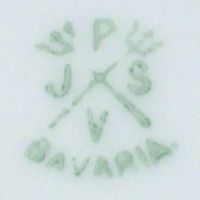
Image 010248-01-02
Used between around 1901 and 1932, here with "Bavaria" as part of the mark.
(Picture: Mark Royse)
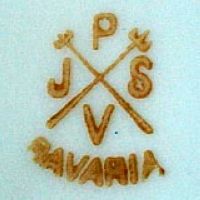
Image 010248-01-03
Used between around 1901 and 1932, same as before only in red.
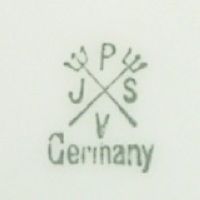
Image 010248-01-04
Used between around 1901 and 1932, here with "Germany" addition. Many from this mark family are smudged ...

Image 010248-01-05
... like this example
(Picture: Hollie Toppin)
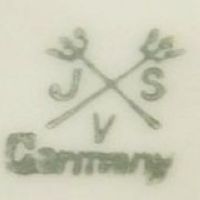
Image 010248-01-06
Nearly same as before but note the missing "P".
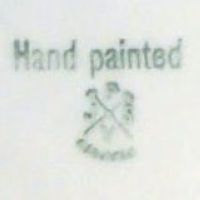
Image 010248-01-07
Used between around 1901 and 1932, "Germany" as part of the mark and "hand painted" addition.
(Picture: Fran Kerbs)
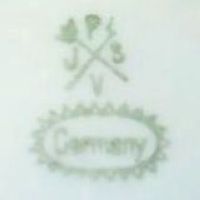
Image 010248-01-08
Used between around 1901 and 1932, "Germany" in an oval as additional mark.
(Picture: Fran Kerbs)
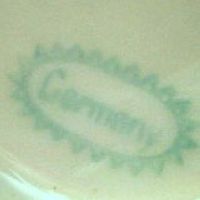
Image 010248-01-09
Used between around 1901 and 1932, sometimes this peculiar "Germany" is the only mark present.
(Picture: Fran Kerbs)

Image 010248-01-10
Used between 1901 and 1914.
(Picture: Fran Kerbs)
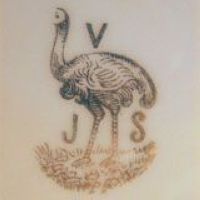
Image 010248-01-11
Used between 1901 and 1914, a near perfect example of a golden version.
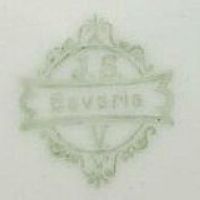
Image 010248-01-12
Used between 1911 and around 1932, here in light green, registered at the RWZR under №·141·909 on April 3rd 1911.
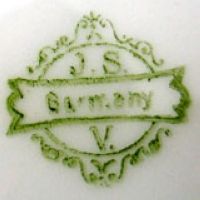
Image 010248-01-13
Used between 1911 and around 1932, some versions were stamped in a much darker green.
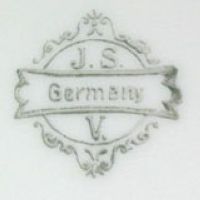
Image 010248-01-14
Used between 1911 and around 1932, here in black.
(Picture: Fran Kerbs)

Image 010248-01-15
Used between 1911 and around 1932, another example in red.
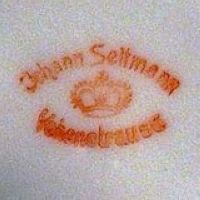
Image 010248-01-16
Used around 1917, a hard to find version without "Bavaria".
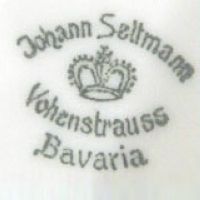
Image 010248-01-17
Used between 1917 and 1932, registered at the RWZR under №·218·445 on June 23rd 1917.
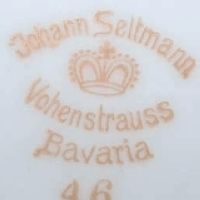
Image 010248-01-18
Used between 1917 and 1932, here an example in red
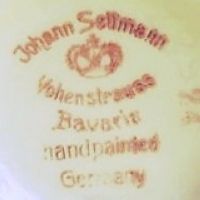
Image 010248-01-19
Used between 1917 and 1932, another example in red but this time with "handpainted" and "Germany" additions.
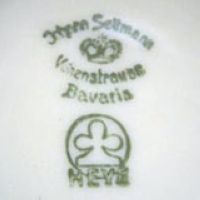
Image 010248-01-20
Used between 1917 and 1932, here with an "Heye" distributor mark addition.
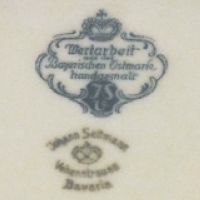
Image 010248-01-21
Used around 1932, additional mark Wertarbeit' above Bayerische Ostmark and "handgemalt".
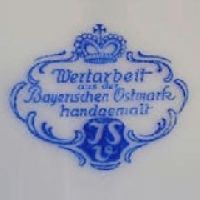
Image 010248-01-22
Used around 1932, closeup of the "Wertarbeit" addition ("JSV" included in the bottom part).
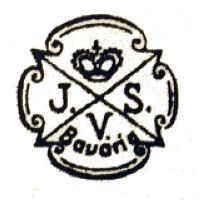
Image 010248-01-23
Used between 1933 and 1945. Initials "JS above V" and "Bavaria".
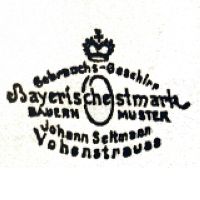
Image 010248-01-24
Used between 1935 and 1945. Crowned "Gebrauchs-Geschirr" above Bayerische Ostmark and "Bauern Muster".
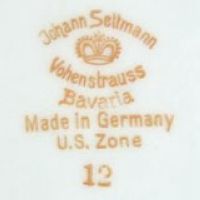
Image 010248-01-25
Used between 1946 and 1949. A re-used pre-war mark with "Made in Germany" and "US Zone" addition.
(Picture: Fran Kerbs)
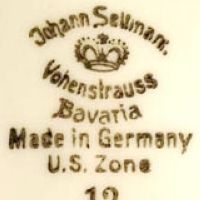
Image 010248-01-26
Used between 1945 and 1949. Same as before only in gold.
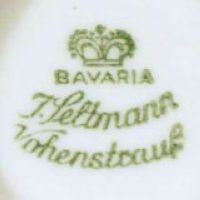
Image 010248-01-27
Used between 1949 and around 1955. This mark form was often (but not always) used when space was restricted.
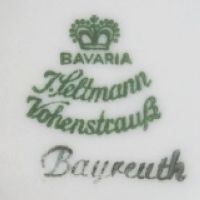
Image 010248-01-28
Used between 1949 and around 1955. Another example, this time with "Bayreuth" series addition.
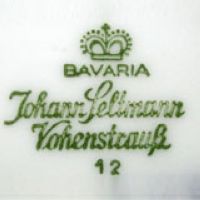
Image 010248-01-29
Used between 1949 and around 1955.
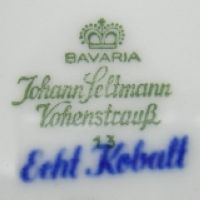
Image 010248-01-30
Used between 1949 and around 1955. Same basic mark but with "Echt Kobalt" addition.
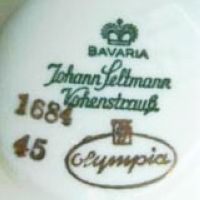
Image 010248-01-31
Used between 1949 and around 1955. Same basic mark but with "Olympia" series stamp.

Image 010248-01-32
Used between 1949 and around 1955. Same basic mark but with "Venezia" series stamp.
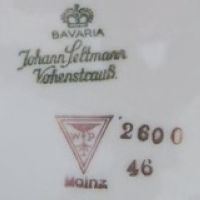
Image 010248-01-33
Used between 1949 and around 1955. Same basic mark but with "WTP" and "Mainz" decorator/retailer addition.
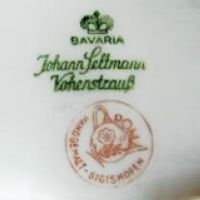
Image 010248-01-34
Used between 1949 and around 1955. "APOMA" mark including "Handgemalt - Sigishofen" (misleading, it's actually from Sonthofen).
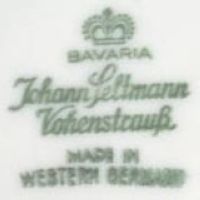
Image 010248-01-35
Used between after 1955 with the "Made in Western Germany" addition.
(Picture: Fran Kerbs)

Image 010248-01-36
Another example with the "Made in Western Germany" addition in a different green.
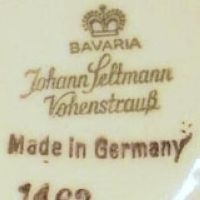
Image 010248-01-37
Used a little later, same basic mark in gold but with simpler "Made in Germany" addition.
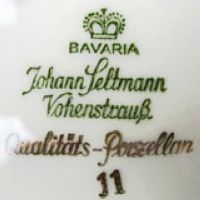
Image 010248-01-38
No date known, but the "Qualitäts-Porzellan" addition (here in gold) was (depending on source) introduced around 1960.
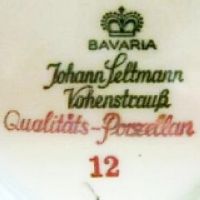
Image 010248-01-39
No date known, here with red "Qualitäts-Porzellan" addition.
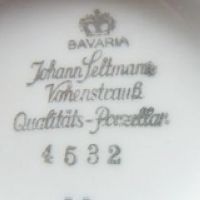
Image 010248-01-40
No date known, same as before but with integrated "Qualitäts-Porzellan" from around 1963.
(Picture: Monika Birkl)
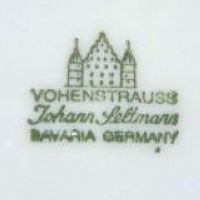
Image 010248-02-01
Introduced 1955 in a few different versions. Here the building is missing the horizontal line over the bottom six windows.
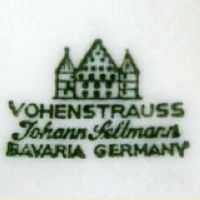
Image 010248-02-02
Introduced 1955 in a few different versions. Example of a complete version without additions, some had an oval around them.
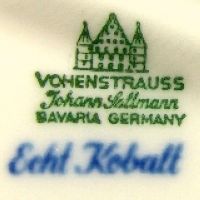
Image 010248-02-03
Introduced 1955 in a few different versions. Here an example with "Echt Kobalt" addition.
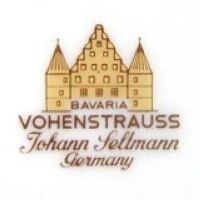
Image 010248-02-04
Introduced 1955 in a few different versions. And here is a colored version.
(Picture: Fran Kerbs)
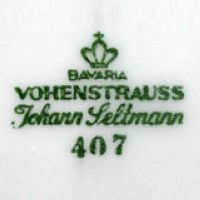
Image 010248-02-05
Used from around 1965, the green version.
(Picture: Janice Hingston)
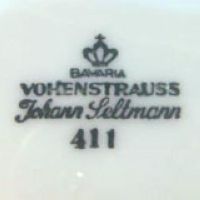
Image 010248-02-06
Used from around 1965, a dirty dark green (almost black) version.
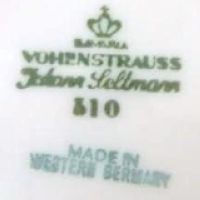
Image 010248-02-07
Used from around 1965, this earlier version still shows "Made in Western Germany" ...
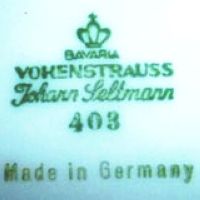
Image 010248-02-08
... while the later ones only stated "Made in Germany".
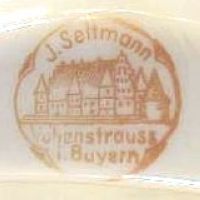
Image 010248-02-09
No date known, text reads "Vohenstrauss" above "i. Bayern" (for "in Bavaria").
(Picture: Fran Kerbs)

Image 010248-02-10
No date known, text reads "Seltmann" above "Vohenstrauss".
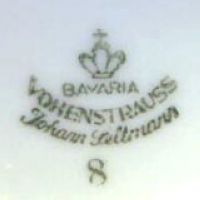
Image 010248-02-11
No date known, the "Vohenstrauss" and "Johann Seltmann" describing an upwards curve on a flat back item (no space restriction).
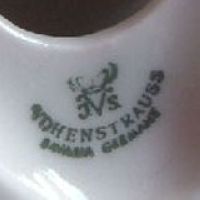
Image 010248-02-12
No date known, a rare and barely documented mark. This however is often found on cramped bases.
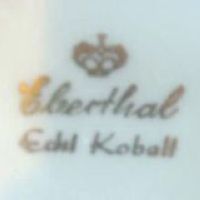
Image 010248-02-13
No exact dates known, early 1950s Eberthal subbrand mark.
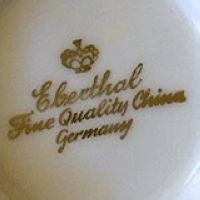
Image 010248-02-14
No exact dates known, example of the most frequently found "Fine Bavarian China" mark.
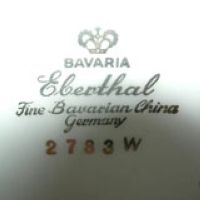
Image 010248-02-15
No exact dates known, another version of the previously mentioned mark.
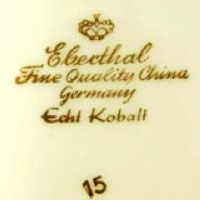
Image 010248-02-16
No exact dates known. Another very similar one, but this time reading "Fine Quality China" and having an "Echt Kobalt" addition.
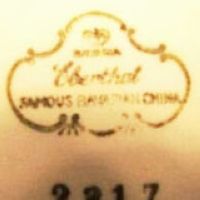
Image 010248-02-17
No exact dates known. Crowned "Bavaria" above "Eberthal" and the line "Famous Bavarian China" surrounded by a border.
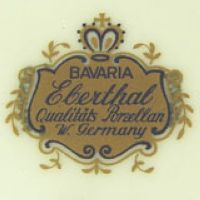
Image 010248-02-18
No exact dates known, very decorative mark mainly in gold.
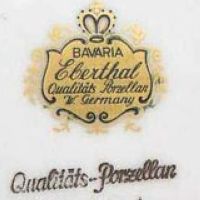
Image 010248-02-19
No dates known. Even if it was already in the mark, "Qualitäts-Porzellan" was sometimes added again.
© 2004-2025 C.S.Marshall, all rights reserved